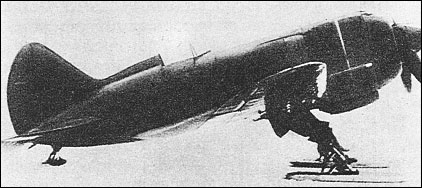|
| Developed from mid 1938 by Dmitrii L Tomashevich
(one of Polikarpov's deputies), the I-180 was originally
conceived with an all-metal structure. Limited all-metal
construction experience, however, led the Polikarpov
OKB to adopt an essentially similar structure to that of
the earlier I-16, with a wooden monocoque fuselage
and a fabric-skinned metal wing. The first prototype,
the I-180.1, was powered by a 1,100hp Tumansky M-88
14-cylinder two-row radial, intended armament being
four 7.62mm guns. This aircraft was lost as a result of
engine failure during its first flight on 15 December
1938. The second prototype, the I-180.2, differed primarily
in having a 1,000hp Tumansky M-87A (later
M-87B) 14-cylinder two-row radial and lengthened
wing outer panels. These increased wing span from
9.00m to 10.05m and area
from 14.68m2 to 16.11m2. First
flown on 19 April 1939, the I-180.2 was lost on its 53rd
flight. A third prototype, the I-180.3 flown on 10
February 1940, featured a redesigned and more
advanced wing structure, a 1,100hp M-88R engine, a
cockpit canopy and an armament of two 12.7mm and
two 7.62mm guns concentrated in the fuselage. Flown
with both wheel and ski undercarriages, the I-180.3
was lost in an accident during State Acceptance Trials.
In the meantime, a pre-series of 10 aircraft based on the
I-180.2 had been under construction as the I-180S
(Seriyny or Series), the first three of these having been
completed in December 1939. The I-180S was powered
by the M-88R and carried an armament of two 12.7mm
and two 7.62mm fuselage-mounted guns, and, like the
I-180.3, featured an enclosed cockpit. The I-180S was
cleared for service trials, but the results of these were
somewhat academic as this fighter had been overtaken
by the more advanced I-185. As a part of the I-185 development
programme, one pre-series I-180S fighter
had the dated triangulated pattern mainwheel legs replaced
with legs of cantilever type, this aircraft being
referred to as the I-180Sh, the suffix indicating Shassi
(chassis). In the event, it was not completed and flown,
the entire I-180 programme having meanwhile been
abandoned.
 | A three-view drawing (1278 x 842) |
| WEIGHTS |
| Take-off weight | 2456 kg | 5415 lb |
| Empty weight | 2046 kg | 4511 lb |
| DIMENSIONS |
| Wingspan | 10.09 m | 33 ft 1 in |
| Length | 6.88 m | 23 ft 7 in |
| Wing area | 16.11 m2 | 173.41 sq ft |
| PERFORMANCE |
| Max. speed | 585 km/h | 364 mph |
| Anonymous, 24.08.2022 18:07 After the government cancelled the I-17 project, Polikarpov was directed to design a new radial-engine fighter to supersede the I-16. The result was the I-180. Unfortunately, a series of accidents, one of which killed one of the leading Soviet test pilots, ruined the reputation of the I-180. It also tarnished the reputation of Polikarpov, who fell out of favor with the Soviet Government and was nearly imprisoned for "treason". reply | | bombardier, e-mail, 23.05.2011 15:08 Aircraft design and politics are things that shouldn't be mixed reply | | Matthew Warren, e-mail, 10.03.2011 17:08 It's a great looking aircraft, with the reverse swept trailing edge. I wonder if the stall charistics of this aircraft might be very abrupt. I have flown the T-38 and the F-111, both swept wing of course. They both have sink rates, below min flying speeds, but they also both recover quickly from this level wing, 6000 to 10000 feet per minute sink rate. By pushing the stick forward, trading altitude for airspeed, both aircraft then regain flying speed. I believe that the Poli. I-180 would have an abrupt stall leading to spin, unless the torque of that big engine was controlled. The I-180 was pushing the limits of both Russian aircraft designers and the pilots of the time. MW. reply |
|
Do you have any comments?
|
| 
COMPANY
PROFILE
All the World's Rotorcraft
|







